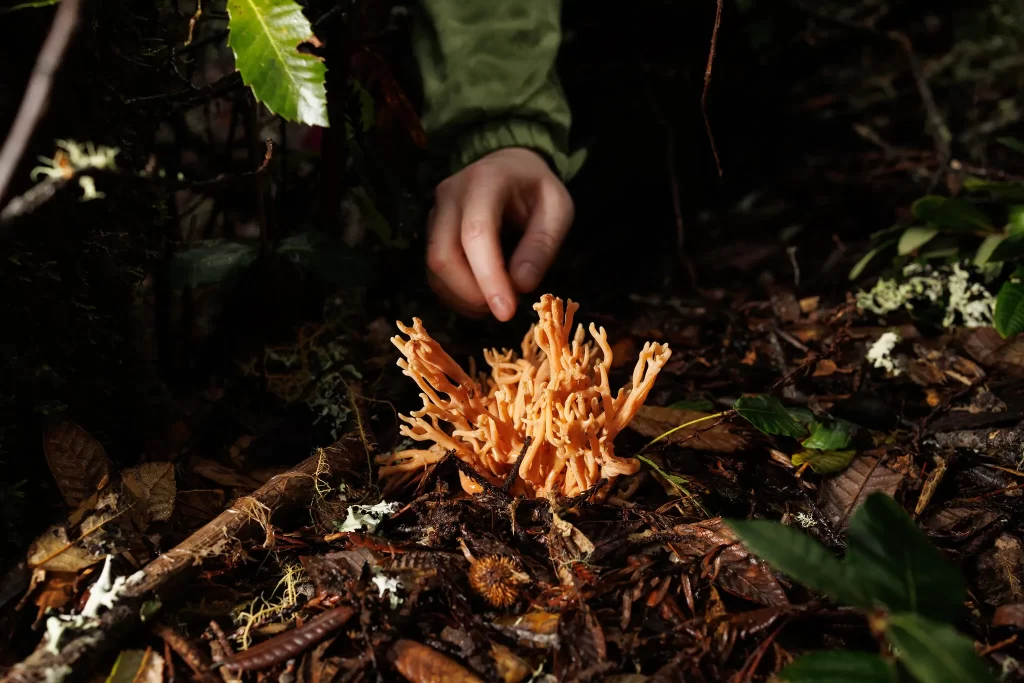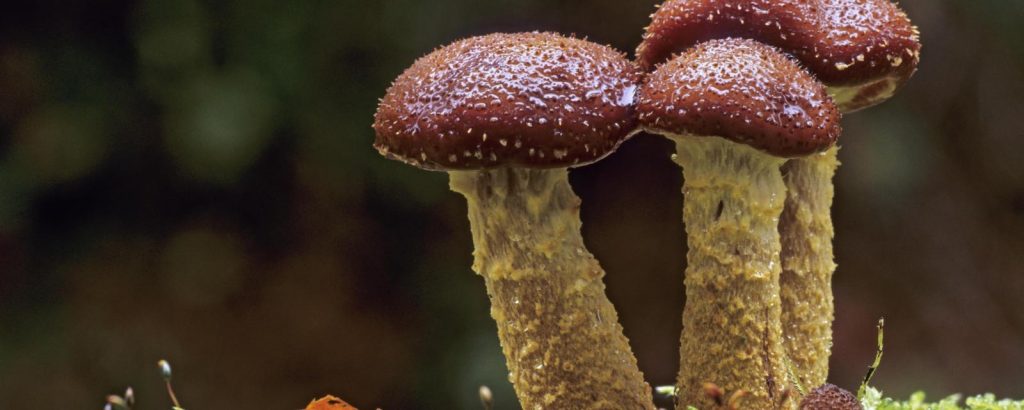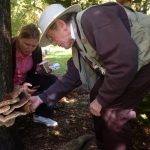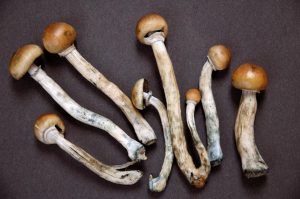For years, mycologists and hobbyists alike have been using DNA sequencing on foraged fungi.
Read more at: https://www.nytimes.com/2024/06/11/science/mushroom-hunters-dna.html

Read more at: https://www.nytimes.com/2024/06/11/science/mushroom-hunters-dna.html

N. Milne, P. Thomsen, N. Mølgaard Knudsen, P. Rubaszka, M. Kristensen, I. Borodina
via https://doi.org/10.1016/j.ymben.2019.12.007
Psilocybin is a tryptamine-derived psychoactive alkaloid found mainly in the fungal genus Psilocybe, among others, and is the active ingredient in so-called “magic mushrooms”. Although its notoriety originates from its psychotropic properties and popular use as a recreational drug, clinical trials have recently recognized psilocybin as a promising candidate for the treatment of various psychological and neurological afflictions. In this work, we demonstrate the de novo biosynthetic production of psilocybin and related tryptamine derivatives in Saccharomyces cerevisiae by expression of a heterologous biosynthesis pathway sourced from Psilocybe cubensis. Additionally, we achieve improved product titers by supplementing the pathway with a novel cytochrome P450 reductase from P. cubensis. Further rational engineering resulted in a final production strain producing 627 ± 140 mg/L of psilocybin and 580 ± 276 mg/L of the dephosphorylated degradation product psilocin in triplicate controlled fed-batch fermentations in minimal synthetic media. Pathway intermediates baeocystin, nor norbaeocystin as well the dephosphorylated baeocystin degradation product norpsilocin were also detected in strains engineered for psilocybin production. We also demonstrate the biosynthetic production of natural tryptamine derivative aeruginascin as well as the production of a new-to-nature tryptamine derivative N-acetyl-4-hydroxytryptamine. These results lay the foundation for the biotechnological production of psilocybin in a controlled environment for pharmaceutical applications, and provide a starting point for the biosynthetic production of other tryptamine derivatives of therapeutic relevance.
Let the vote begin! A group of scientists passionate about the importance of lichens in Canada is asking Canadians to vote on a proposed national species. Voters can choose from a list of seven candidates up until March 20 by visiting nature.ca/lichenvote.
The scientists make the case that lichens are diverse and ecologically important, with Canada having among the highest lichen biomass globally. Evocative names such as Horsehair Lichen, Elegant Sunburst Lichen, and Star-tipped Reindeer Lichen convey the diversity of these unique organisms— part fungi and part algae and/or cyanobacteria—that occupy important niches in the natural world.
“There are more than 2,500 species of lichens in Canada, and with this vote, we want to promote greater recognition of this unique group of organisms,” says Dr. Troy McMullin, research scientist and lichenologist with the Canadian Museum of Nature, who is facilitating the project. “The environments where lichens are most abundant—the boreal forest and arctic-alpine—cover most of Canada’s large land mass.”
Lichens are among the first colonizers of bare rock and prevent erosion by stabilizing soil. Some fix atmospheric nitrogen for the soil and are the main source of food for caribou in winter months. They provide food, shelter, and camouflage for other animals, and have been used for traditional medicines and dyes. They are also useful biological indicators of air quality.
“Lichens serve as excellent indicators of air pollution,” notes McMullin. “Specific species can be considered as ‘canaries in the coalmine’ since they are sensitive to atmospheric pollutants. Other species are excellent indicators of ecological integrity as many species only occur in environments that have remained undisturbed for long periods of time, such as old-growth forests.”
The seven lichens eligible for the vote met a number of criteria: being widespread in Canada and more common in Canada than in other countries, as well as for their ability to be recognized, their beauty, and their functions in nature. One or more scientists served as a champion for each lichen by providing a written description to make the case as a national species.
The initiative for a national lichen is part of a larger project McMullin has facilitated with lichen experts across the country to identify a proposed lichen species for each province and territory.
The voting form, which includes descriptions and photos of each lichen under consideration, can be found at nature.ca/lichenvote.
Brief summaries of the seven candidates (more detailed descriptions in the voting form):
Boreal Oakmoss Lichen (Evernia mesomorpha): common in virtually all forested environments across Canada, this conspicuous lichen hangs on the boles and branches of trees and is also common on wooden fence rails and posts. This species is tolerant of air pollution, so it commonly occurs in parks and woodlots near urban areas.
Common Freckle Pelt Lichen (Peltigera aphthosa): a large lichen that occurs across Canada, from coast to coast, and into the High Arctic. It blankets moss, soil, and low shrubs in exposed moist areas, but also tree bases and rocks in deeply shaded old-forest habitats. Nearly half of all known occurrences worldwide are in Canada.
Concentric Ring Lichen (Arctoparmelia centrifuga): a familiar sight on large boulders and rock outcrops in the Arctic and boreal regions of Canada, it is a closely attached, yellowish-green species that forms concentric rings. The abundance of the species and the comparative ease of culturing the fungal component from spores makes it a good candidate for a model species. It is distributed from the east to west coasts and throughout the Arctic.
Elegant Sunburst Lichen (Xanthoria elegans): a spectacular bright orange species that grows mostly on rocks and bones, but occasionally on soil and wood. It is most common on shoreline rocks throughout Canada and on bones and rocks in the Arctic. The presence of this species is used by hunters to locate nests and burrows.
Horsehair Lichen (Bryoria sp.): can be considered the defining lichen genus of the boreal forest, which in turn is the defining ecosystem of Canada as a whole. This lichen appears as intricate brown tresses festooning the branches of fir, spruce, and pine. Horsehair lichen was the basis of a crucial starvation food for some of Canada’s Indigenous peoples and remains an important forage item for flying squirrels, voles, caribou and, to varying degrees, ungulates as a group.
Star-tipped Reindeer Lichen (Cladonia stellaris): forms yellowish green, rounded, foam-like tufts that cover thousands of square kilometres of boreal woodland soil and also extend into the temperate parts of southern Canada. Abundant in every province and territory, this lichen is easily recognized because of the appearance of cauliflower-like heads. This lichen is a primary winter food for both wild and domesticated reindeer and caribou.
Yellow Map Lichen (Rhizocarpon geographicum): Widespread across Canada, it is readily recognizable and is closely associated with the Canadian Shield and mountain landscapes. It is one of the only crustose lichens (those that grow closely attached to their substrate) that most people know. Its common name is apt for a country with such a large geography and a history of cartography.
The scientists that nominated the lichens for the vote are: Alain Belliveau, Acadia University, Nova Scotia; Dr. Troy McMullin, and Dr. Irwin Brodo, Canadian Museum of Nature; Dr. Michele Piercey-Normore and Dr. Yolanda Wiersma, Memorial University, Newfoundland and Labrador; Dr. Teuvo Ahti, University of Helsinki, Finland; Trevor Goward, University of British Columbia, and Juliet Pendray, Victoria, British Columbia.
By Richard Gray
15 March 2019

Normally associated with rot and decay, fungi may be a great overlooked resource that could help humanity deal with some of its greatest problems. Beneath Jim Anderson’s feet lies a monster. It has been alive since the Persian king Xerxes waged war against the Ancient Greeks and weighs more than three blue whales put together. It has a voracious appetite, eating its way through huge swathes of forest. But this is no long-forgotten beast borne of Greek mythology. It is a mushroom…
Read more at www.bbc.co.uk

Search crews fear the rescue of a mushroom picker who went missing overnight in B.C.’s Interior may be the first of many similar calls this summer.
Kamloops Search and Rescue were called Saturday evening when the man failed to return to his camp near Loon Lake, roughly 130 kilometres north of Kamloops, B.C. He was found the following morning.
“It was a long night out there … the mosquitos were just horrendous,” said KSAR member Mike Ritcey.
Last summer’s wildfires have led to a bumper crop of mushrooms in the Interior this year and pickers are expected to flock to the area.
Read more at CBC.ca
Gary Lincoff, a self-taught mycologist whose contagious enthusiasm turned him into a pied piper of mushrooms, died on March 16 in Manhattan. He was 75.

Credit: Alan Zale for The New York Times
His family said he died after a stroke.
Mr. Lincoff, a philosophy major and law-school dropout, wrote a field guide to North American mushrooms that sold more than a half-million copies. He led mushroom hunts as far afield as Siberia, India and the Amazon and as near to his home as Central Park, two blocks away, where over the course of decades he counted more than 400 species.
Mr. Lincoff taught for more than 40 years at the New York Botanical Garden in the Bronx and instructed Martha Stewart on dredging puffballs in panko bread crumbs to bring out their flavor. He wrote peer-reviewed journal articles and poems and songs about mushrooms, and helped found the countercultural science and fun fair in Colorado known as the Telluride Mushroom Festival.

(Photo by Photofusion/Universal Images Group via Getty Images)
The evidence supporting the use of psychedelic drugs to treat treatment-resistant depression continues to build. In the latest volley, a study finds that psilocybin, the psychoactive ingredient in magic mushrooms, may open an entirely new door to treating depression – by allowing deeply entrenched beliefs to become changeable.
Read more at Forbes – Original article by David DiSalvo.